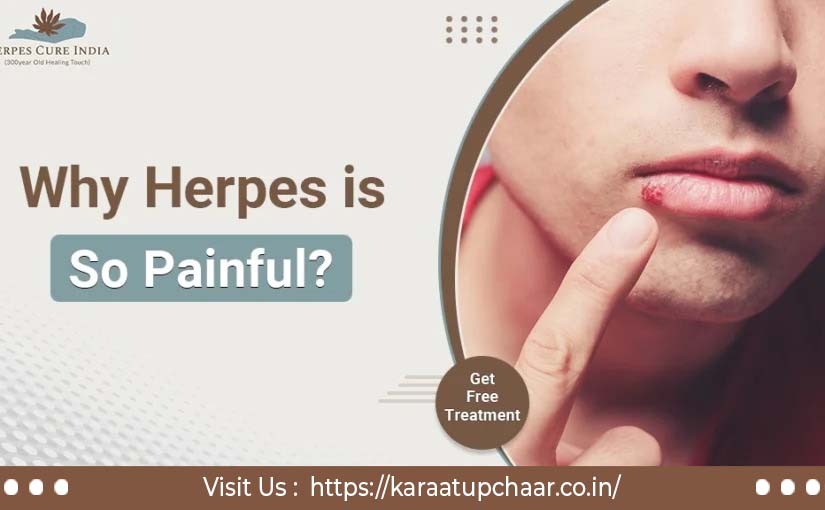
Herpes Cure: Why Herpes Zoster is so Painful?
Acute herpes zoster is often accompanied by discomfort that lasts long after the rash has healed. Patients with herpes zoster experience a range of uncomfortable symptoms. According to current studies, different types of pain vary in their presence, location, length, intensity, and quality; hence, pain must be studied in greater depth. The type and duration of this pain differ, and finding an effective Herpes Cure is crucial for relief. Post-herpetic neuralgia (PHN) is the name for pain that persists after the rash from herpes zoster has gone away.
When compared to other common diseases, the medical repercussions of herpes are disproportionately high. When the infection isn’t treated effectively, several complications arise. The non-adherence to antiviral drug treatment plans recommended by medical professionals also poses a significant problem in finding a lasting Herpes Cure.
One of the well-known effects of herpes is pain in various parts of the body, such as the back and the legs, along with a burning sensation and a desire to scratch. Although there are no definitive studies on the topic, it stands to reason that when the herpes virus is combined with nerve pain, it may cause a wide variety of pain that is not localized to any one area of the body. The herpes simplex virus (HSV-1 or HSV-2) can cause pain, particularly when symptoms flare up or inflammation in the nerves occurs, making the need for an effective Herpes Cure even more pressing.
The most common causes of pain include degenerative disc disease, spondylosis, osteomyelitis, epidural abscess, and malignancy. When left untreated, the inflammation caused by these conditions in the spine and muscles may become chronic. Anti-inflammatory supplements are recommended to help relieve the pain and swelling that come with these conditions, though a complete Herpes Cure remains elusive.
Levels of Pain in the Herpes Cure Process
When infected with the virus, you will experience many stages of pain.
The First Phase
This stage occurs two to eight days after infection. Usually, the infection causes clusters of small, painful blisters. The blister fluid may be transparent or cloudy. Underneath the blisters, the skin will be red. Blisters burst and develop into open sores. The blisters may or may not be noticeable or uncomfortable. Urinating at this time may be painful. While the majority of patients have a painful first infection stage, others do not. They may be oblivious to their condition. The pain experienced at this stage varies greatly from person to person. While pain can be exacerbated in children and the elderly, when the blister occurs at the site and is scratched unknowingly, it can cause severe pain.
Dormant Period
During this phase, there are no outward symptoms such as blisters or lesions. The virus has penetrated your skin and is now infecting your spinal cord nerves. Mostly, this stage doesn’t result in external pain, as the virus remains dormant for a long period before reactivating due to factors like depression, anxiety, HIV/AIDS, or menstruation. This period of dormancy is a significant challenge in finding a comprehensive herpes medication treatment.
The Shedding Phase
The replication of the virus in nerve endings starts during the shedding phase. If these nerve endings are located in or often come into contact with bodily fluids, the virus may enter the body. Saliva, sperm, and genital fluids all fall under this category. Even if there are no signs of illness at this time, the virus might still spread. It’s an indication that the herpes virus is spreading rapidly right now. While the virus is still replicating, the infected person can still experience pain. The pain is not only caused by the herpes virus spreading but also because of a weakened immune system. In addition to the herpes virus, several other factors contribute to the persistence of pain, highlighting the need for a Herpes Cure.
Recurrences of the Herpes Virus
Many individuals experience blisters and sores after the initial herpes outbreak subsides. This is known as a recurrence. Symptoms are often less severe than during the first bout.
Recurrences may be triggered by anxiety, illness, or fatigue. Being exposed to the sun or having your period might also induce a recurrence. If you experience itching, tingling, or discomfort in previously infected areas, you should be on the lookout for a recurrence. This becomes the last stage of pain, although the severity is generally lower than in the first phase. However, the pain can be significantly more intense in the elderly, children, and individuals suffering from other diseases, emphasizing the ongoing need for an effective Herpes Cure.

